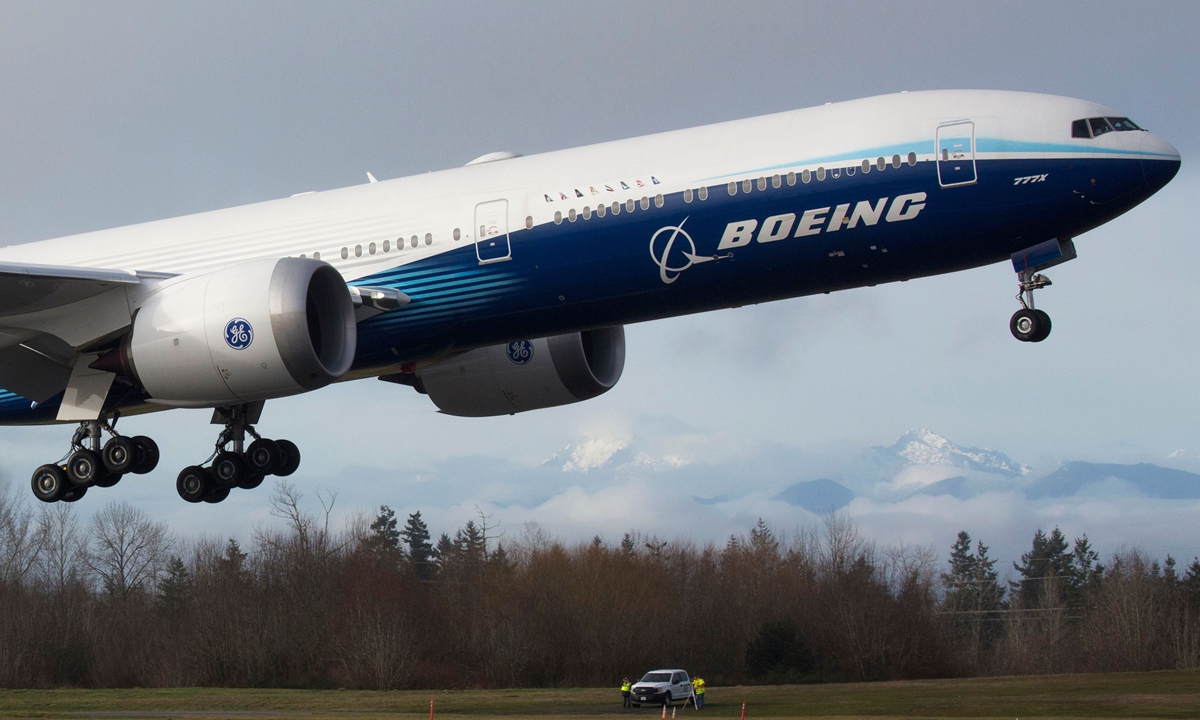Boeing forecasts demand for nearly 44,000 new airplanes through 2043; China to lead all markets with 20% of demand

A Boeing 777X aircraft takes off on its inaugural flight from Paine Field at Everett, Washington State, the US on January 25, 2020. File Photo: VCG
Aircraft manufacturer Boeing updated its market outlook, raising the demand for civil aircraft in the next 20 years from 42,595 in 2023 to nearly 44,000, an increase of approximately 3.24 percent, and China will lead all markets, being the largest single country market.
Air travel demand continues to outpace economic growth in an increasingly connected world. Four years after the pandemic grounded most of the global fleet, air traffic growth has returned to the long-term trend Boeing forecast 20 years ago.
Compared to 2023, passenger air traffic will rise an average of 4.7 percent annually over the next two decades, according to the forecast.
Boeing said South Asia passenger traffic will increase 7.4 percent, followed by Southeast Asia (7.2 percent) and Africa (6.4 percent), as emerging markets return to historical growth trends through the forecast period.
Eurasia is projected to lead all markets in airplane deliveries, accounting for 22 percent of the total, with North America and China each close behind at 20 percent, it said.
In terms of aircraft types, single-aisle aircraft will account for 71 percent of the fleet in 2043, while the growth of twin-aisle aircraft is mainly in the Middle East, which will account for 44 percent of the Middle East fleet in the future.
Boeing's rival Airbus also forecast in July that 45 percent of newly delivered aircraft will be used for replacements. Airbus predicts that the number of aircraft in its global fleet will double to 48,320 by 2043, while the number of aircraft in its global fleet in service in 2023 was 24,260.
Corresponding to the doubling of transport capacity, Airbus believes that passenger volume will more than double in the next 20 years.
In the first three years, passenger traffic will grow at an annual rate of about 8 percent to make up for growth lost during the epidemic. Starting in 2027, this indicator will return to about 3.6 percent. Airbus also believes that market growth in China and India will further shift the focus of aviation industry development to Asia.
However, contrary to optimistic market forecasts, the aircraft manufacturing chain is still "stuck" due to the loss of skilled technicians after the epidemic, shortage of raw materials, geopolitics and other factors, market insiders said.
Caixin reported that it will probably take 1-2 years for the supply chain to be fully restored.
Boeing is in the spotlight due to the door blowout incident earlier this year. In order to improve production quality, it lowered production speed. As of the first half of this year, Boeing has delivered 175 aircraft, 91 fewer than last year.
Data from Boeing's official website showed that it delivered 44 aircraft in June, making it Boeing's best month this year.
The Commercial Aircraft Corporation of China (COMAC), the manufacturer of the home-made large aircraft C919 is also trying to grab a share of the aircraft manufacturing market. Up to now, COMAC has delivered six passenger aircraft to China Eastern Airlines.
COMAC has brought 1:20 scale C919 and C929 aircraft models to the public at the ongoing Farnborough International Air Show in the UK, according to information it shared with the Global Times.
Global Times



